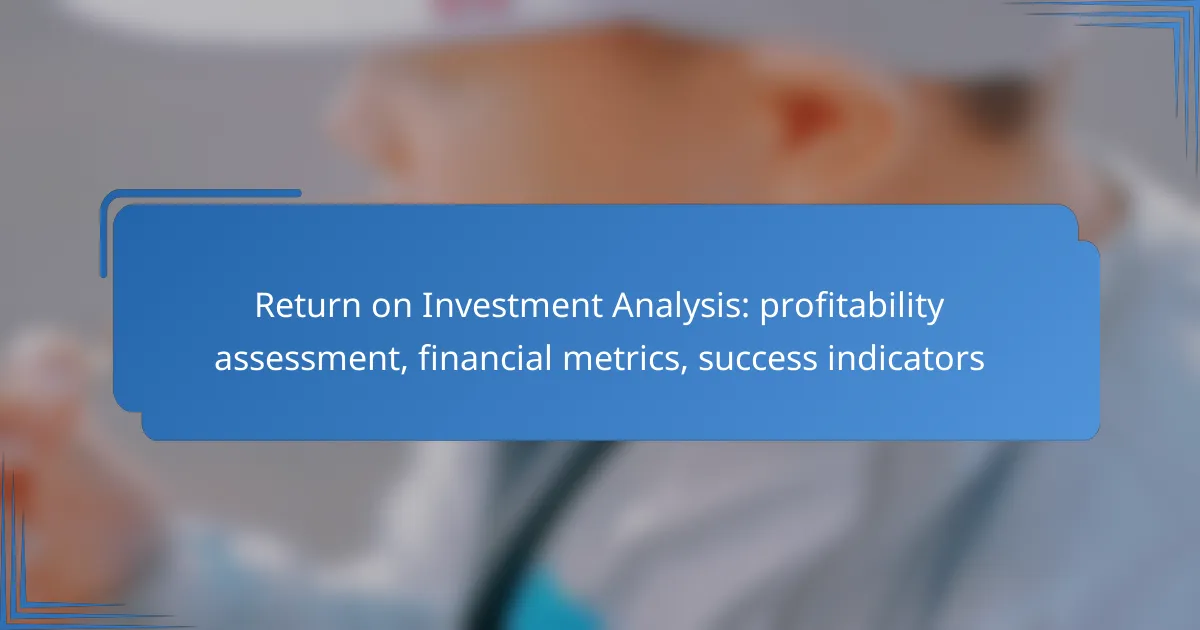Return on Investment (ROI) analysis is essential for evaluating the profitability of investments in e-commerce, allowing businesses to assess the financial viability of their strategies. By examining key financial metrics such as gross margin percentage and customer acquisition cost, companies can make informed decisions that enhance their profitability. Additionally, monitoring success indicators like sales growth rate and return on advertising spend provides valuable insights into overall financial performance.

How to assess Return on Investment in e-commerce?
Assessing Return on Investment (ROI) in e-commerce involves evaluating the profitability of your investments relative to the costs incurred. This analysis helps determine whether your e-commerce strategies are financially viable and can guide future business decisions.
Calculate net profit
To calculate net profit, subtract total expenses from total revenue generated from your e-commerce activities. This figure represents the actual earnings after accounting for costs such as product sourcing, shipping, marketing, and operational expenses.
For example, if your e-commerce store generates $100,000 in sales and incurs $70,000 in expenses, your net profit would be $30,000. This net profit is essential for calculating ROI and assessing the effectiveness of your investments.
Determine total investment
Total investment includes all costs associated with launching and maintaining your e-commerce business. This can encompass initial setup costs, ongoing marketing expenses, website maintenance, and any technology investments.
For instance, if you spend $10,000 on website development, $5,000 on marketing, and $2,000 on inventory, your total investment would be $17,000. Understanding this figure is crucial for accurately calculating ROI.
Use ROI formula
The ROI formula is straightforward: ROI = (Net Profit / Total Investment) x 100. This calculation provides a percentage that indicates the efficiency of your investment in generating profit.
Using the previous examples, if your net profit is $30,000 and your total investment is $17,000, the ROI would be approximately 176.5%. This high ROI suggests that your e-commerce strategies are yielding significant returns, guiding future investment decisions.

What financial metrics are essential for ROI analysis?
Key financial metrics for ROI analysis include gross margin percentage, customer acquisition cost, and lifetime value of a customer. These metrics help businesses evaluate profitability and make informed investment decisions.
Gross margin percentage
Gross margin percentage measures the difference between revenue and the cost of goods sold, expressed as a percentage of revenue. It indicates how efficiently a company uses its resources to produce goods or services. A higher gross margin percentage suggests better profitability.
To calculate gross margin percentage, use the formula: (Revenue – Cost of Goods Sold) / Revenue x 100. For many industries, a gross margin of 40-60% is considered healthy, but this can vary significantly based on the sector.
Monitor gross margin trends over time to identify potential issues with pricing, production costs, or sales strategies. A declining margin may signal the need for operational improvements or pricing adjustments.
Customer acquisition cost
Customer acquisition cost (CAC) is the total expense incurred to acquire a new customer, including marketing and sales costs. Understanding CAC is crucial for assessing the effectiveness of marketing strategies and overall profitability. A lower CAC indicates a more efficient acquisition process.
To calculate CAC, divide total marketing and sales expenses by the number of new customers acquired in a specific period. Aim for a CAC that is significantly lower than the lifetime value of a customer to ensure profitability.
Be cautious of overspending on customer acquisition. Regularly review marketing channels and strategies to optimize costs and improve the return on investment from each customer acquired.
Lifetime value of a customer
Lifetime value (LTV) of a customer estimates the total revenue a business can expect from a single customer throughout their relationship. LTV helps businesses understand how much they can invest in acquiring new customers while remaining profitable. A higher LTV indicates stronger customer loyalty and retention.
To calculate LTV, consider the average purchase value, purchase frequency, and customer lifespan. A common formula is: LTV = Average Purchase Value x Purchase Frequency x Customer Lifespan. Many businesses aim for an LTV that is at least three times the CAC.
Focus on strategies that enhance customer retention, such as loyalty programs or personalized marketing. Increasing customer lifetime value can significantly improve overall profitability and reduce the pressure on acquisition costs.

What success indicators should be monitored?
Monitoring success indicators is crucial for assessing the profitability of investments. Key metrics such as sales growth rate, conversion rate, and return on advertising spend provide insights into financial performance and help guide strategic decisions.
Sales growth rate
The sales growth rate measures the percentage increase in sales over a specific period. This indicator helps businesses understand their revenue trajectory and market demand. A healthy sales growth rate typically ranges from 10% to 20% annually for established companies, while startups may aim for even higher growth.
To calculate the sales growth rate, subtract the previous period’s sales from the current period’s sales, divide by the previous period’s sales, and multiply by 100. For example, if sales increased from $100,000 to $120,000, the growth rate would be 20%.
Regularly tracking this metric allows businesses to identify trends and adjust strategies accordingly. A declining sales growth rate may signal the need for new marketing efforts or product innovations.
Conversion rate
The conversion rate indicates the percentage of visitors who take a desired action, such as making a purchase or signing up for a newsletter. This metric is essential for evaluating the effectiveness of marketing campaigns and website performance. A typical conversion rate for e-commerce sites ranges from 1% to 5%.
To calculate the conversion rate, divide the number of conversions by the total number of visitors and multiply by 100. For instance, if 200 out of 10,000 visitors made a purchase, the conversion rate would be 2%.
Improving the conversion rate can significantly enhance profitability. Strategies include optimizing website design, simplifying the checkout process, and using targeted marketing to reach the right audience.
Return on advertising spend
Return on advertising spend (ROAS) measures the revenue generated for every dollar spent on advertising. This metric helps assess the effectiveness of advertising campaigns and guides budget allocation. A common benchmark for ROAS is a return of at least $4 for every $1 spent, though this can vary by industry.
To calculate ROAS, divide the revenue generated from ads by the total ad spend. For example, if a campaign costs $1,000 and generates $5,000 in revenue, the ROAS would be 5:1.
Monitoring ROAS allows businesses to identify which campaigns are performing well and which need adjustments. Avoid overspending on underperforming ads, and consider reallocating funds to higher-performing channels for better overall returns.

How to improve ROI in Australian e-commerce?
Improving ROI in Australian e-commerce involves optimizing marketing efforts, enhancing customer experiences, and leveraging data analytics. These strategies can lead to increased sales and better financial performance.
Optimize marketing strategies
To enhance ROI, focus on targeted marketing strategies that reach your ideal customers effectively. Utilize channels like social media, email marketing, and search engine optimization to maximize visibility and engagement.
Consider allocating your budget towards high-performing campaigns. Regularly analyze the performance of each channel to identify which ones yield the best returns, and adjust your spending accordingly.
Enhance customer experience
Improving the customer experience can significantly boost ROI by increasing conversion rates and fostering loyalty. Ensure your website is user-friendly, mobile-optimized, and fast-loading to keep potential buyers engaged.
Implement personalized shopping experiences, such as tailored product recommendations and targeted promotions. Collect feedback to continually refine the customer journey and address pain points promptly.
Implement data analytics tools
Data analytics tools are essential for measuring and improving ROI. Use platforms like Google Analytics to track user behavior, sales trends, and marketing effectiveness. This data helps you make informed decisions about where to invest resources.
Regularly review key performance indicators (KPIs) such as customer acquisition cost and lifetime value. Establish benchmarks to evaluate your progress and adjust strategies based on insights gained from your analytics.

What are the prerequisites for effective ROI analysis?
Effective ROI analysis requires a clear understanding of financial goals, reliable data tracking systems, and well-defined performance metrics. These prerequisites ensure that the assessment of profitability is accurate and actionable.
Clear financial goals
Establishing clear financial goals is essential for effective ROI analysis. These goals should be specific, measurable, achievable, relevant, and time-bound (SMART). For example, a company might aim to increase revenue by 15% over the next year.
When financial objectives are well-defined, it becomes easier to evaluate the success of investments against these targets. This clarity helps in prioritizing projects that align with the overall business strategy.
Accurate data tracking systems
Accurate data tracking systems are crucial for gathering reliable information on expenses and revenues. Implementing tools like accounting software or project management applications can streamline data collection and ensure that all financial transactions are recorded consistently.
Regular audits of these systems can help identify discrepancies and improve data integrity. For instance, using automated reporting tools can reduce human error and provide real-time insights into financial performance.
Defined performance metrics
Defined performance metrics provide a framework for evaluating the effectiveness of investments. Common metrics include net profit margin, return on assets, and customer acquisition cost. Each metric offers insights into different aspects of financial health and investment success.
Choosing the right metrics depends on the specific goals of the business. For example, a startup may focus on customer acquisition cost to ensure sustainable growth, while an established company might prioritize net profit margin to assess overall profitability.
